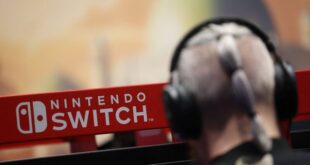SEOUL (Reuters) -South Korea’s SK Hynix said on Wednesday the memory chip market was beginning to recover from a deep downturn amid robust artificial intelligence demand, sending its shares higher even though it reported a second-quarter operating loss.
In particular, memory chip demand from corporate buyers and gaming personal computers is expected to increase in the second half of the year versus the first, the world’s second-biggest memory chip maker said in a statement.
SK Hynix shares rose 1.8% in early trade, versus a flat wider market.
Memory chip makers cut production in the first half of this year as prices continued to fall due to slumping demand from buyers amid economic headwinds, causing steep writedowns to the value of unsold stockpiles.
Market conditions remain mixed depending on the type of chips. SK Hynix said on Wednesday it would cut more production of its NAND Flash chips used for data storage because of high inventories and low profitability amid a fall in the average sales price.
But a boom in AI helped it boost sales of high-end DRAM chips in the second quarter and narrow losses from the previous quarter.
SK Hynix reported a 2.9 trillion won ($2.28 billion) operating loss in the April to June quarter, down from 4.2 trillion won profit a year earlier on weak memory chip pricing and demand.
This compared with expectations for a 2.7 trillion won operating loss, according to 22 analyst views compiled by Refinitiv SmartEstimate, weighted toward analysts that are more consistently accurate.
SK Hynix has reported losses each quarter since the fourth quarter of 2022, although the June quarter loss narrowed from a record of 3.4 trillion won loss in the March quarter.
Revenue fell 47% year-on-year to 7.31 trillion won in the June quarter.
AI CHIPS
SK Hynix said demand for AI server memory had increased rapidly. Its DRAM chips, which hold information from applications while the system is in use, sold for a higher price in the second quarter versus the first, on average.
SK Hynix leads the market in high bandwidth memory (HBM) DRAM used in the fast-growing field of generative AI. It had a 50% market share in HBM as of 2022, followed by Samsung Electronics’ 40% and Micron’s 10%, according to TrendForce.
HBM can feed more data into chips used for generative AI, enabling them to compute at high speed.
SK Hynix’s DRAM business is expected to swing to a profit in the fourth quarter thanks to strong sales of premium products, said Greg Roh, head of research at Hyundai Motor Securities.
“But NAND Flash demand from Chinese mobile firms may continue to stagnate until year-end,” leaving the chipmaker’s return to full profit uncertain, he added.
Samsung, the world’s biggest memory chip maker, will report its detailed second-quarter financial results on Thursday.
($1 = 1,274.1300 won)
(Reporting by Joyce Lee and Heekyong Yang; Editing by Christopher Cushing and Jamie Freed)
 BeritaKini.biz Berita Viral Terkini di Malaysia
BeritaKini.biz Berita Viral Terkini di Malaysia





